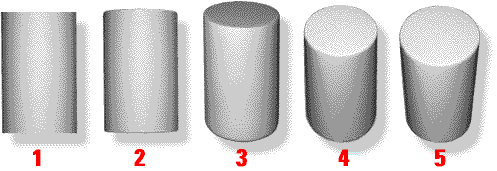Simple volume and projection solutions

The cylinders above illustrate several variations of volume description.
1:An easy way to indicate volume is to make turning edges a different value than the full bellies of the form. On white paper, you could darken the edges of the form. In gesture sketching, you can do this very quickly by making a loose collection of lines at the edges, like in the illustrations below. You may notice that artifacts from a searching style can automatically describe this kind of volume.2:Illustration (1) has a flat top and bottom, but you may want to indicate that you are both looking up at the top, and down at the bottom of the cylinder, as in this figure (2). Notice the curvature on top and bottom. This happens in figure drawing, like in some of the figures below.3:Illustration (3) causes you to be looking down at the top and down at the bottom. The top is closer to you, right? That means the top is projecting toward you.4:Illustration (3) isn't as extreme projection as (4). Relative angle of view is suggested by the roundness of the ellipses associated with the cylinder. Including round or compressed ellipses and also, using tonal change at form turning edges, will combine the sense of volume and projection.5:If you show perspectively converging lines over distance (things get smaller with distance), you get more of a sense of recession.
The Sphere
Many forms in the figure are sphere-like, and can be handled as volumes accordingly. Like the illustration below, all you need to do is loosely circle the full parts. The edges will recede and the center areas will appear full.
Gesture Intro Page